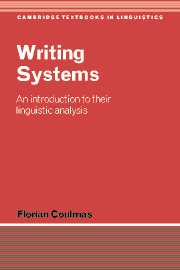Book contents
- Frontmatter
- Contents
- List of illustrations
- List of tables
- Acknowledgements
- A note on fonts
- List of abbreviations and conventions
- 1 What is writing?
- 2 The basic options: meaning and sound
- 3 Signs of words
- 4 Signs of syllables
- 5 Signs of segments
- 6 Consonants and vowels
- 7 Vowel incorporation
- 8 Analysis and interpretation
- 9 Mixed systems
- 10 History of writing
- 11 Psycholinguistics of writing
- 12 Sociolinguistics of writing
- Appendix: Universal Declaration of Human Rights, article 1
- Bibliography
- Index of names
- Index of subjects
11 - Psycholinguistics of writing
Published online by Cambridge University Press: 05 June 2012
- Frontmatter
- Contents
- List of illustrations
- List of tables
- Acknowledgements
- A note on fonts
- List of abbreviations and conventions
- 1 What is writing?
- 2 The basic options: meaning and sound
- 3 Signs of words
- 4 Signs of syllables
- 5 Signs of segments
- 6 Consonants and vowels
- 7 Vowel incorporation
- 8 Analysis and interpretation
- 9 Mixed systems
- 10 History of writing
- 11 Psycholinguistics of writing
- 12 Sociolinguistics of writing
- Appendix: Universal Declaration of Human Rights, article 1
- Bibliography
- Index of names
- Index of subjects
Summary
When he was reading, his eye glided over the pages, and his heart searched out the sense, but his voice and tongue were at rest.
AugustineWriting requires deliberate analytic action on the part of the child. In speaking, he is hardly conscious of the sounds he produces and quite unconscious of the mental operations he performs. In writing, he must take cognizance of the sound structure of each word, dissect it, and reproduce it in alphabetic symbols, which he must have studied and memorized before.
Lev S. VygotskyForeigners always spell better than they pronounce.
Mark TwainIn the previous chapter we noted that the introduction of writing implies a cognitive reorientation and a restructuring of symbolic behaviour. Names of objects are conceptually dissociated from their denotata, as signs of physical objects are reinterpreted as signs of linguistic objects, names. In a second step, signs of names are recognized as potentially meaningless signs of bits of sound, which are then broken down into smaller components. This cognitive reorientation first happened five thousand years ago, and philosophers have speculated about the human capacity to produce and process visible signs since antiquity. The scientific investigation of the literate mind is, however, of relatively recent origin. Yet, testifying to the importance of writing in modern times, it has grown into a vast field of research dealing with the psychological differences between Language by Ear and by Eye, to quote the title of a seminal book by James Kavanagh and Ignatius Mattingly.
- Type
- Chapter
- Information
- Writing SystemsAn Introduction to Their Linguistic Analysis, pp. 210 - 222Publisher: Cambridge University PressPrint publication year: 2002



